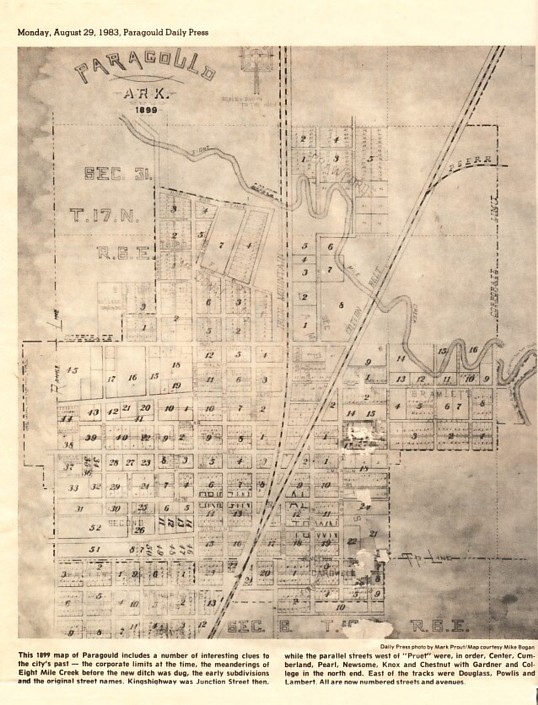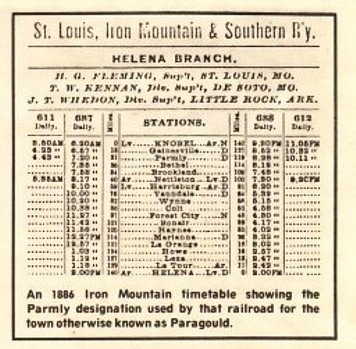
|
A Paragould is a Parmly is "The Crossing." Would a town by any other name still
be home, sweet home? Like much of local history, the story of Paragould's name is pock-marked with unanswered questions and conflicting information. There is no question, of course, that the town was -- eventually -- named for J. W. Paramore and Jay Gould, the two railroad tycoons who built competing lines from the southern cotton fields to the St. Louis commodity markets. When Paramore's "yard-wide line" and Gould's Helena Branch crossed paths in Greene County, the site was first known by the simple generic description of "The Crossing." But, of course,a site with such commercial potential had to have a town and a proper name. W. S. Pruet and J. J. Lambert, who owned much of the land that eventually became Paragould, laid out the original town -- which is labeled on old plats as Original Town --an area now bounded by Hunt, Third and Vine streets and Fourth Avenue. A1936 writer takes up the story from here. "The citizens began racking their brains for a suitable name for the new-born community, not being satisfied with 'Parmly' and the 'Crossing' as it was being designated," an unidentified histor-ian wrote in a Souvenir Program prepared for the grand opening of Crowley's Ridge State Park. "It was reasoned that J.W. Para-more and Jay Gould, the railroad promoters, more than anybody else, were responsible for the new community's birth, hence it was fitting that the city of the future should bear one of these names," the writer continued. "But how to choose one man's name with hurting the feelings of the other was a problem. And so, 'Doc' Edring-ton, father of Ed Edrington now residing in the Center Hill com-munity, |
coined the name Paragould." The Missouri Pacific Railroad, successor to Gould's line, tells a slightly different story in its 1957 corporate history, The Empire That Missouri Pacific Serves.: "Rivalry between the officials of the two railroads to name this Arkansas town in honor of their respective 'chiefs' resulted in a compromise and the coined word, 'Paragould,' as its name. "In 1881, the famed Jay Gould was president of the Iron Moun-tain Railroad, now the Missouri Pacific, and Colonel J.W. Para-more was the head of the Cotton Belt Railroad, which crossed the Iron Mountain at this site. The officers of both railroads insisted that the new town bear the name of their head. After heated argu- ments a compromise was reached and the town was christened 'Paragould,' a combination of both presidents' names in 1882. What this section leaves out is Gould's apparent outrage at getting second billing to his nemesis, Para-more. But, really now, would Goulamore have caught on? Still, Gould's railway continued to use its Parmly designation for several years. Just how long is one of the unanswered questions. But the Iron Mountain station here was still listed a Parmly on the 1886 timetable shown on this page. The designation naturally created quite a bit of confusion. There are numerous stories around town of people arriving in Para-gould, seeing the Parmly station sign and thinking that had got off at the wrong train stop. And no one, not even the Miss-ouri Pacific, has been able to ex-plain just who or what the Parmly name came from. (Some Mo-Pac records indicate the name was also spelled "Parmlee," but a railroad spokesman believes the timetable spelling is the correct one.)
|
